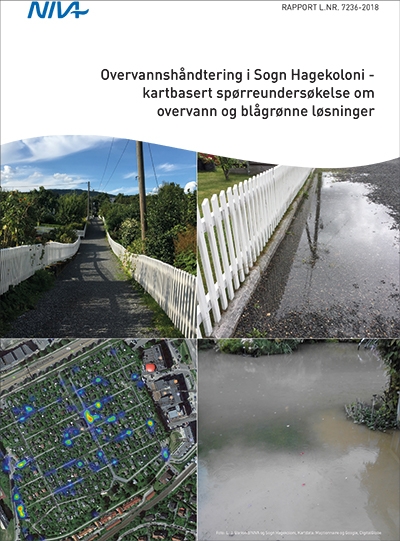Mapping stormwater and blue-green solutions in Sogn allotment garden
As part of iResponse we have conducted a participatory map-based survey in Sogn allotment garden in Oslo (Norway) and has summed up the results in a report.
Sogn Hagekoloni is one of in total nine allotment gardens in Oslo city. An allotment garden is a piece of land made available for individual gardening by the local authority or a private property owner, and is divided into several plots, so-called parcels, in addition to common areas. Sogn Hagekoloni covers about 87 hectare and has 204 parcels which each also has a small cabin for recreational living during the season April-October.
The allotment garden is located within Oslo city in the upper part of the Gaustad valley, which is dominated by loamy soil. After extreme precipitation events, there are several places in the garden where stormwater accumulates and causing inconvenience. Under a changing climate, episodes of heavy rainfall are expected to increase, potentially leading also to more stormwater.
As part of iResponse we conducted a map-based survey using the participatory mapping tool Maptionnaire, which is a partner in the project. The work was done in collaboration with the board of the allotment garden and the study took place during summer and autumn 2017.
The aim was to involve the allotment gardeners in the mapping of areas with stormwater accumulation after heavy rainfall, and potential places for implementing blue-green, nature-based, measures to handle the stormwater. The survey was also designed to understand gardeners’ perceptions of stormwater and their motivations to implement stormwater measures. Overall, 98 participated. The process and results is summed up in the report (in Norwegian).
Areas with stormwater accumulations
The gardeners reported 193 spots in the allotment garden where water accumulates after heavy rainfall. These spots were spread over the entire area, with some concentrations close to the common house and in the southwestern part of the garden area. The mapped locations coincide with a paper map drawn in 2015 based on some gardeners’ observations and measurements, as well as a drainage lines map developed by Oslo municipality showing where water will theoretically flow, but also show some additional places.
Potential places for blue-green solutions
The participants also suggested 82 potential locations in the garden for blue-green stormwater measures. Blue-green, or also so-called nature-based solutions make use of nature for handling and using the stormwater as a resource in the urban landscape. They include e.g. use of rain gardens, trees, stripes of vegetation, open streams.
The suggested locations generally coincided with the locations for the mapped stormwater accumulations, yet with some deviations possible due to perceived suitability for physical measures at the specific locations.
When asked about their preference for different stormwater measures, the allotment gardeners showed a preference for using rain gardens, open drainage channels/streams and the use of rain barrels. Open channels were seen as favorable if implemented in the common areas, but they were less popular if they were to be placed/go through individual parcels.
Motivating factors for contributing to stormwater management
Important motivating factors for contributing to stormwater management actions were economic support to implement measures, cooperation with others and sufficient information about possible solutions.
The most important factor was that Oslo municipality, which is the owner for the allotment garden land area, takes a shared responsibility for the implementation of stormwater measures in the area.
Providing a basis for further activities
The study explored and shows the usefulness of using a digital map-based tool within a confined area and group of participants; it enabled collection of observations, opinions, and ideas about stormwater and possible management options for the specific area. The results and insights forms a basis for follow-up dialogue and activities to arrive at a holistic stormwater management implementation for the area.
We are currently working on how to move into practical implementation of some blue-green measures in the allotment garden. This will be done using a living lab approach taking into account several dimentions including water-related, social, aesthetical,and education purposes. This will become part of a dedicated follow-up demo activity in collaboration with the allotment garden and Oslo Municipality. The activity will be connected to the research project New Water Ways that just started. New Water Ways builds partially upon iResponse case work and focus on urban stormwater management and blue-green infrastructure.
We have also conducted a similar Maptionnaire study for the whole of Oslo city during summer and autumn 2017 and we are currently analyzing the data and writing up the results that will be shared.
Report: Barkved, L.J., Seifert-Dähnn, I. and Langaas, S., 2018. Overvannshåndtering i Sogn Hagekoloni-kartbasert spørreundersøkelse om overvann og blågrønne løsninger. NIVA-rapport 7236-2018, Oslo, Norge.
